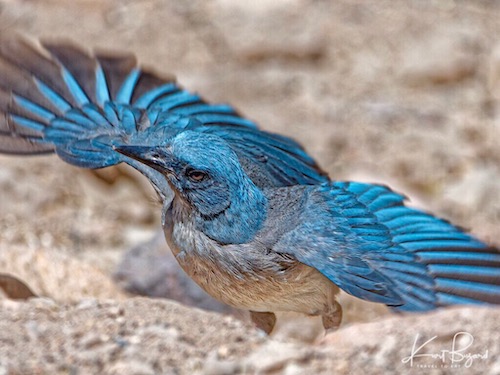
The larger birds of Sierra Vista are outstanding in terms of their colors and shapes. Arizona is a vast landscape of bold color, formations and piercing beauty. The southeastern corner is no exception. Isolated mountains called “Sky Islands” rise abruptly from the arid desert highlands, harbor a tremendous variety of plant and animal life and border the San Pedro Valley. The unique grassland of the valley is supported by the San Pedro River, which enters Arizona from Sonora, Mexico and flows north to join the Gila River. A significant percentage of American birders, if asked to choose their single favorite regional destination, would pick southeastern Arizona. Within a relatively small region here, you can find Sonoran Desert, oak woodland, high-elevation conifer forest, and riparian areas. The list of special species is long, but a few highlights are Montezuma Quail, Gray Hawk, Violet-crowned Hummingbird, Elegant Trogon, Arizona Woodpecker, Northern Beardless-Tyrannulet, Buff-breasted Flycatcher, Olive Warbler, Rufous-winged Sparrow, and Yellow-eyed Junco.
Greater Roadrunner
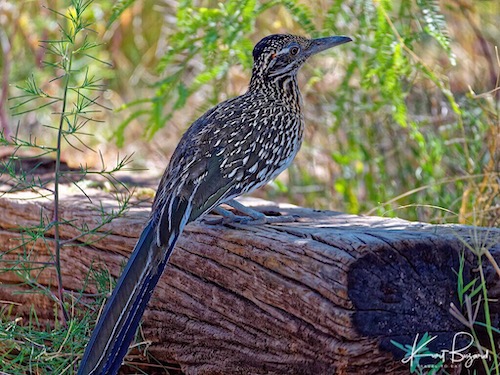
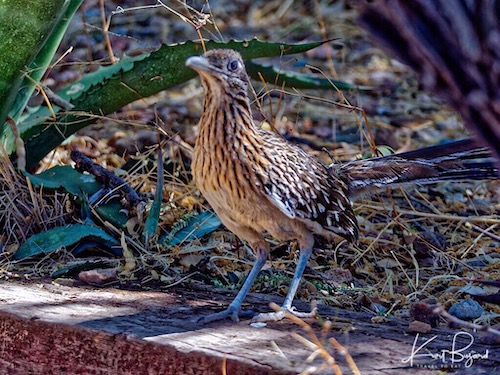
The Greater Roadrunner (Geococcyx californianus) is a long-legged bird in the cuckoo family, Cuculidae, from Southwestern United States and Mexico. The Latin name means “Californian earth-cuckoo”. Along with the lesser roadrunner, it is one of two species in the roadrunner genus Geococcyx. This roadrunner is also known as the chaparral cock, ground cuckoo, and snake killer. The roadrunner is about 20–24 in (52–62 cm) long, has a 17–24 in (43–61 cm) wingspan and weighs 7.8–19.0 oz (221–538 gm). It stands around 9.8–11.8 in (25–30 cm) tall and is the largest cuckoo of the Americas. Roadrunners have four toes on each foot, two face forward, and two face backward. The toes are brown in color and have pale gold spots. The upper body is mostly brown with black streaks and sometimes pink spots. The neck and upper breast are white or pale brown with dark brown streaks, and the belly is white. A crest of brown feathers sticks up on the head, and a bare patch of orange and blue skin lies behind each eye, the blue is replaced by white in adult males (except the blue adjacent to the eye), and the orange (to the rear) is often hidden by feathers.
Northern Cardinal
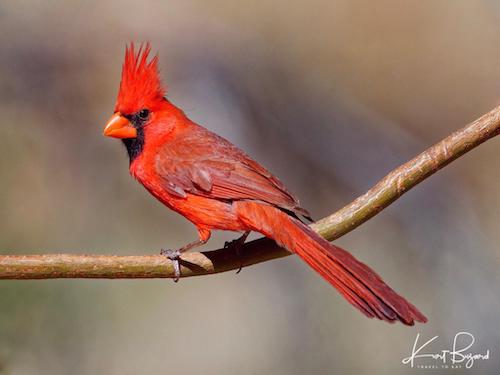
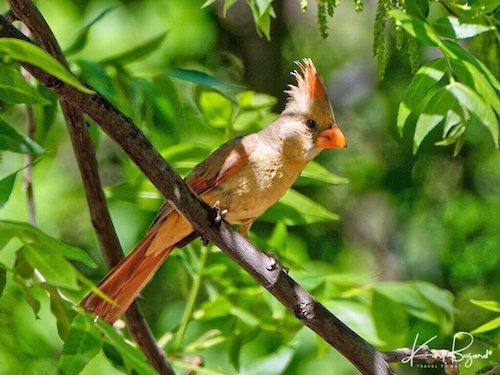
The northern cardinal (Cardinalis cardinalis) is a North American bird in the genus Cardinalis; it is also known colloquially as the redbird, common cardinal or just cardinal (which was its name prior to 1985). It can be found in southern Canada, through the eastern United States from Maine to Texas and south through Mexico, Belize and Guatemala. Its habitat includes woodlands, gardens, shrublands, and wetlands. The northern cardinal is a mid-sized songbird with a body length of 8.3–9.1 in (21–23 cm). It has a distinctive crest on the head and a mask on the face which is black in the male and gray in the female. The male is a vibrant red, while the female is a dull reddish olive. I have written on the Cardinal before but on this trip I saw both the male and female and I thought I would include them.
Mexican Jay
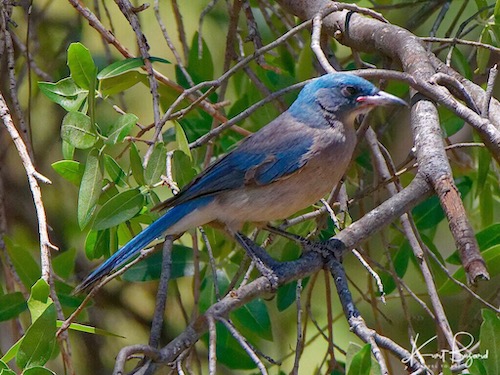
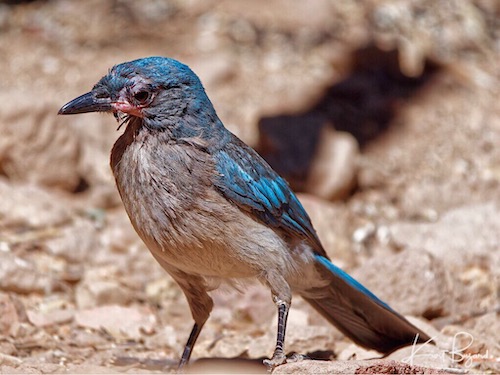
The Mexican jay (Aphelocoma wollweberi) formerly known as the gray-breasted jay, is a New World jay native to the Sierra Madre Oriental, Sierra Madre Occidental, and Central Plateau of Mexico and parts of the southwestern United States. The Mexican jay is a medium-sized jay with blue upper parts and pale gray underparts. It resembles the western scrub jay, but has an unstreaked throat and breast. It feeds largely on acorns and pine nuts, but includes many other plant and animal foods in its diet. It has a cooperative breeding system where the parents are assisted by other birds to raise their young. The sexes are similar, and juveniles differ only in having less blue coloration and, in some populations, a pink/pale (instead of black) bill that progressively becomes more black with age.
Pinion Pine Jay
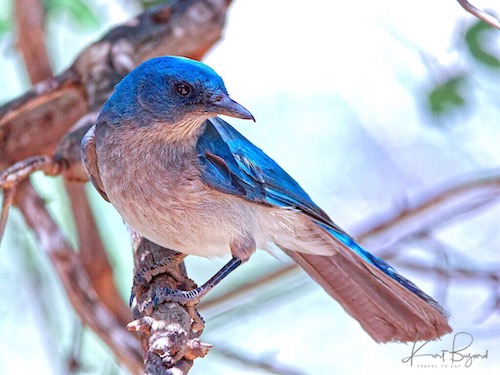
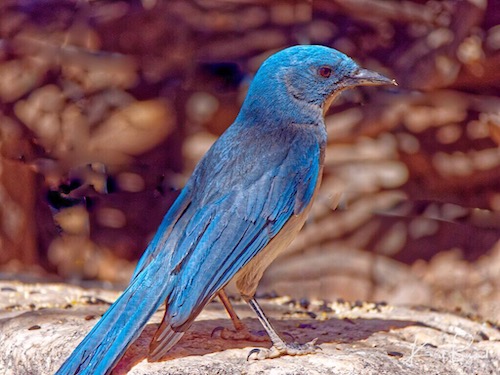
The Pinyon Jay (Gymnorhinus cyanocephalus), historically known as the blue crow or Maximilian’s jay, is a jay between the North American blue jay and the Eurasian jay in size. It is the only member of the genus Gymnorhinus. Its overall proportions are very nutcracker-like and indeed this can be seen as convergent evolution as both birds fill similar ecological niches. The Pinyon Jay is a bluish-grey colored bird with deeper head coloring and whitish throat with black bill, legs and feet. This species occurs in western North America from central Oregon to northern Baja California and east as far as western Oklahoma though it wanders further afield out of the breeding season. It lives in foothills where the pinyon pines Pinus edulis and Pinus monophylla occur. Pinyon-juniper woodlands are characterized as arid, semiarid, or occasionally, dry subhumid. The mean annual temperature varies from 40 to 61 °F (4–16 °C). The climate of ponderosa pine forests in the western United States is arid to semiarid. Weather is an important factor influencing the breeding success and survival of pinyon jays.
Gambel’s Quail
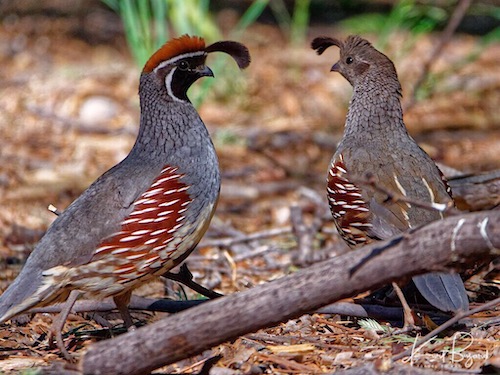
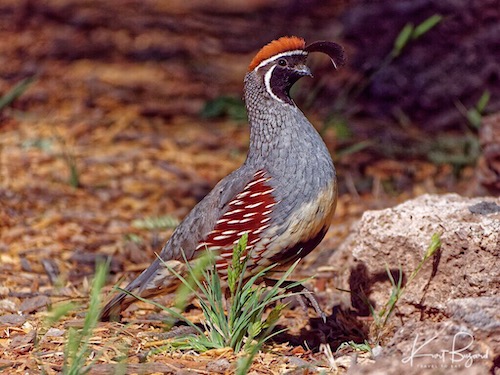
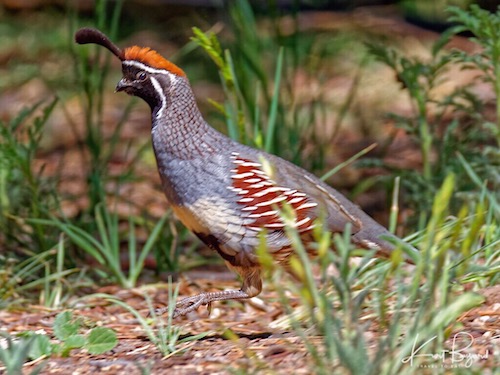
The Gambel’s quail (Callipepla gambelii) is a small ground-dwelling bird in the New World quail family. It inhabits the desert regions of Arizona, California, Colorado, New Mexico, Nevada, Utah, Texas, and Sonora; also New Mexico-border Chihuahua and the Colorado River region of Baja California. The Gambel’s quail is named in honor of William Gambel, a 19th-century naturalist and explorer of the Southwestern United States. I just love the Gamble’s quail. their elegant demeanor is equaled only by their shy appearance. The Callipepla gambelii birds are easily recognized by their top knots and scaly plumage on their undersides. Gambel’s quail have bluish-gray plumage on much of their bodies, and males have copper feathers on the top of their heads, black faces, and white stripes above their eyes. The bird’s average length is 11 in (28 cm) with a wingspan of 14–16 in (36–41 cm). These birds have relatively short, rounded wings and long, featherless legs. Its diet consists primarily of plant matter and seeds.
Inca Dove or Mexican Dove
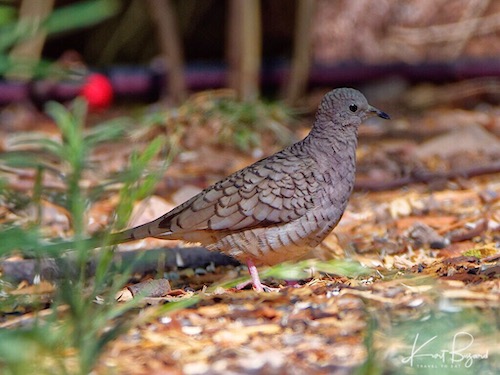
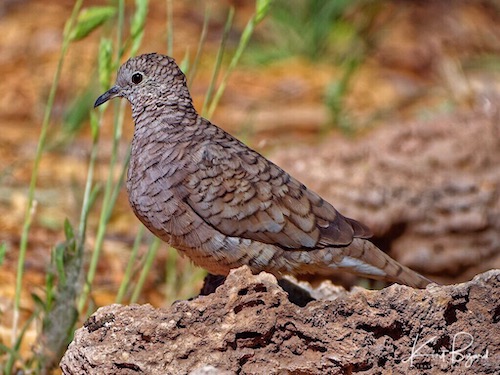
The Inca dove or Mexican dove (Columbina inca) is a small New World dove. Inca doves reach a length of 6.5–9.1 in (16.5–23 cm) and weigh 1.1–2.0 oz (30–58 gm). They are slender, with a gray-brown body covered in feathers that resemble a scaled pattern. The tail is long and square and edged with white feathers that may flare out in flight. The underwings are reddish, like other ground doves, and upon takeoff, the wings produce a distinctive, quiet rattling noise. The Inca Dove ranges from Costa Rica in the south to the American Southwest in the north and is often common to abundant in suitable habitat. Despite being named after the Inca Empire, this species does not occur in any of the lands that once constituted that empire. Inca doves are expanding their range in the north and south. This terrestrial species forms flocks in deserts, scrublands and cultivated areas and may also be found in urban settings where they feed upon grass seeds and take advantage of the ready availability of water from agricultural and suburban irrigation.
Mourning Dove
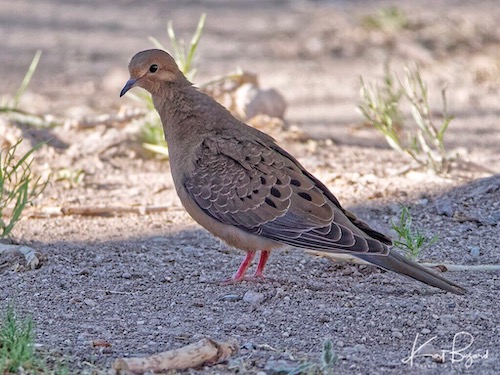
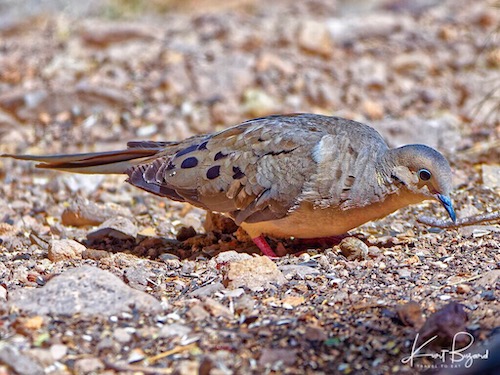
The mourning dove (Zenaida macroura) is a member of the dove family, Columbidae. The bird is also known as the American mourning dove or the rain dove, and erroneously as the turtle dove, and was once known as the Carolina pigeon or Carolina turtledove. It is one of the most abundant and widespread of all North American birds. It is also a leading gamebird, with more than 20 million birds (up to 70 million in some years) shot annually in the U.S., both for sport and for meat. Its ability to sustain its population under such pressure is due to its prolific breeding; in warm areas, one pair may raise up to six broods of two young each in a single year. Mourning doves are light grey and brown and generally muted in color. Males and females are similar in appearance. The species is generally monogamous, with two squabs (young) per brood. Both parents incubate and care for the young. Mourning doves eat almost exclusively seeds, but the young are fed crop milk by their parents.
White Winged Dove
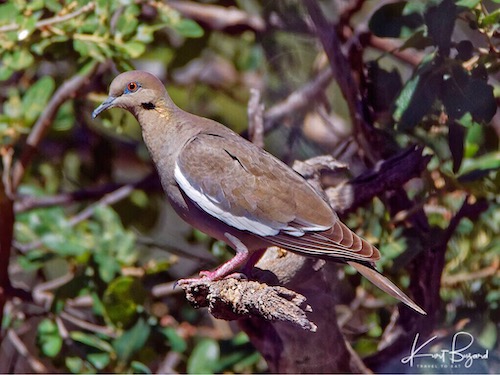
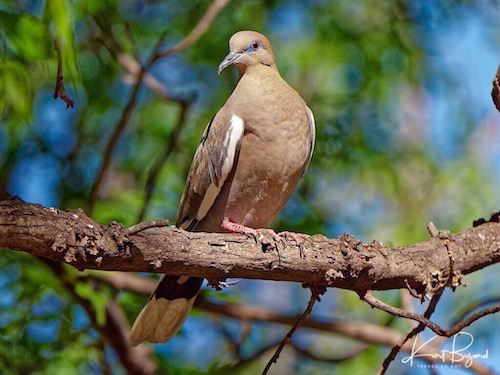
The white-winged dove (Zenaida asiatica) is a dove whose native range extends from the south-western United States through Mexico, Central America, and the Caribbean. In recent years with increasing urbanization and backyard feeding, it has expanded throughout Texas, into Oklahoma, Louisiana and coastal Mississippi. White-winged doves are large, plump doves at 11 in (29 cm). They are brownish-gray above and gray below, with a bold white wing patch that appears as a brilliant white crescent in flight and is also visible at rest. Adults have a patch of blue, featherless skin around each eye and a long, dark mark on the lower face. Their eyes are bright crimson. The sexes are similar, but juveniles are more brown than adults. They have a blue eye ring and their legs and feet are brighter pink/red. Young also have brown eyes. Males have a slight iridescent sheen on their heads.
White-Breasted Nuthatch
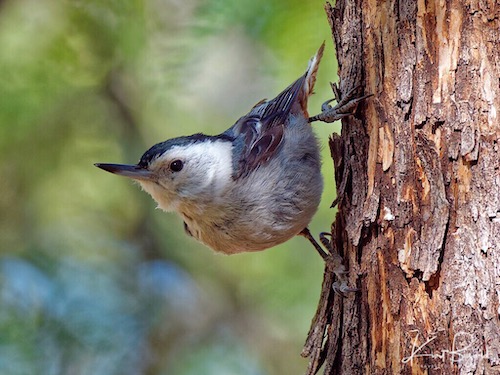
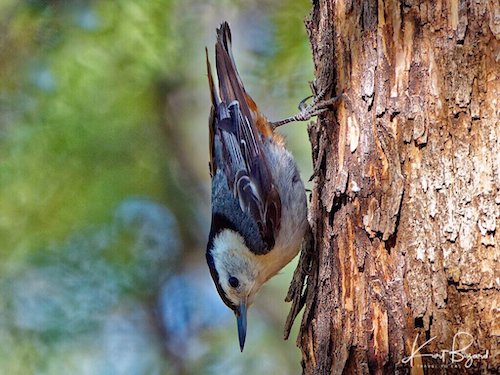
The white-breasted nuthatch (Sitta carolinensis) is a small songbird of the nuthatch family which breeds in old-growth woodland across much of temperate North America. It is a stocky bird, with a large head, short tail, powerful bill, and strong feet. The upperparts are pale blue-gray, and the face and underparts are white. It has a black cap and a chestnut lower belly. The nine subspecies differ mainly in the color of the body plumage. Like other members of its genus, the white-breasted nuthatch has a large head, short tail, short wings, a powerful bill and strong feet; it is 5.1–5.5 in (13–14 cm) long, with a wingspan of 7.9–10.6 in (20–27 cm) and a weight of 0.63–1.06 oz (18–30 gm). The adult male of the nominate subspecies, has pale blue-gray upperparts, a glossy black cap (crown of the head), and a black band on the upper back. The wing coverts and flight feathers are very dark gray with paler fringes, and the closed wing is pale gray and black, with a thin white wing bar. The face and the underparts are white. The outer tail feathers are black with broad diagonal white bands across the outer three feathers, a feature readily visible in flight.
Gila Woodpecker
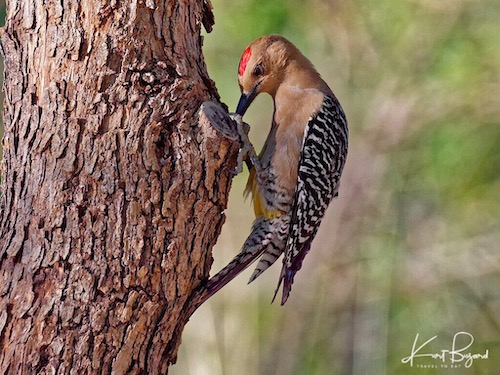
The Gila woodpecker (Melanerpes uropygialis) is a medium-sized woodpecker of the desert regions of the southwestern United States and western Mexico. In the U.S., they range through southeastern California, southern Nevada, Arizona, and New Mexico. The back and wings of this bird are spotted and barred with a black and white zebra-like pattern. The neck, throat, belly and head are greyish-tan in color. The male has a small red cap on the top of the head. Females and juveniles are similar, but both lack the red cap of the adult male. White wing patches are prominent in flight. The dark tail has white bars on the central tail feathers. They range from 8–10 in (20–25 cm) in length.
Acorn Woodpecker
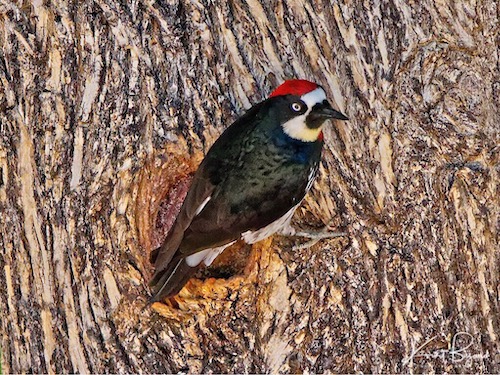
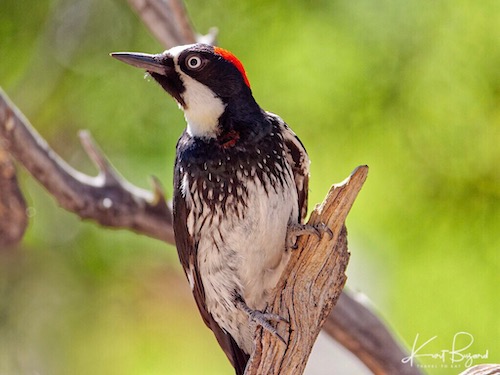
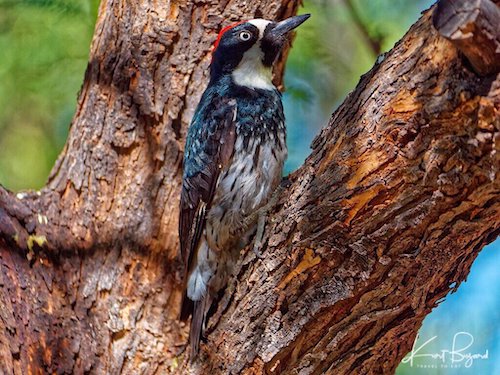
The acorn woodpecker (Melanerpes formicivorus) is a medium-sized woodpecker, 8.3 in (21 cm) long, with an average weight of 3.0 oz (85 gm). The adult acorn woodpecker has a brownish-black head, back, wings and tail, white forehead, throat, belly and rump. The eyes are white. There is a small part on the small of their backs where there are some green feathers. The adult male has a red cap starting at the forehead, whereas females have a black area between the forehead and the cap. The white neck, throat, and forehead patches are distinctive identifiers. When flying, they take a few flaps of their wings and drop a foot or so. White circles on their wings are visible when in flight. Acorn woodpeckers have a call that sounds almost like they are laughing.
Ladderbacked Woodpecker
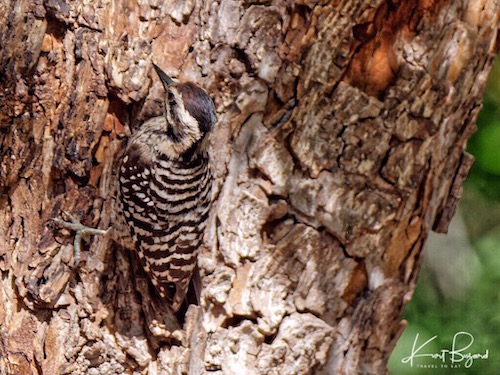
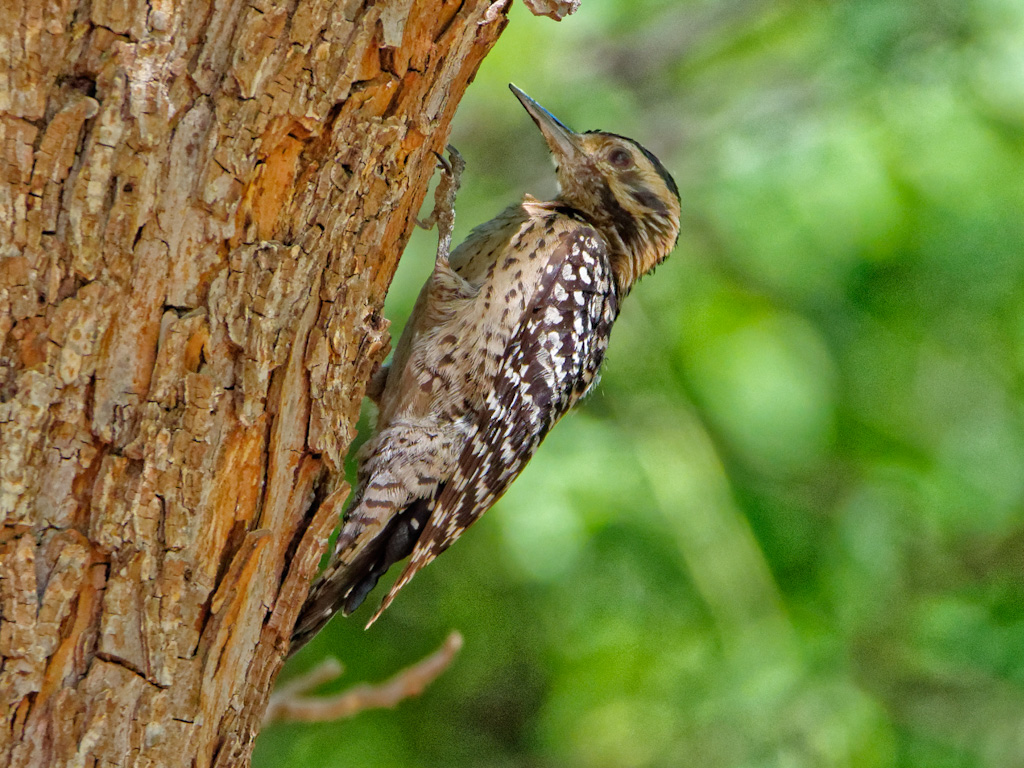
The ladder-backed woodpecker (Dryobates scalaris) is a small woodpecker about 6½ to 7½ inches (16.5 to 19 cm) in length. It is primarily colored black and white, with a barred pattern on its back and wings resembling the rungs of a ladder. Its rump is speckled with black, as are its cream-colored underparts on the breast and flanks. Southern populations have duskier buff breasts and distinctly smaller bills. Adult males have a red crown patch that is smaller in immatures and lacking in adult females. The ladder-backed woodpecker is very similar in appearance to Nuttall’s woodpecker, but has much less black on its head and upper back, and the range of the two species only intersects a minimal amount in southern California and northern Baja California The ladder-backed woodpecker is fairly common in dry brushy areas and thickets and has a rather large range. The species can be found year-round over the southwestern United States (north to extreme southern Nevada and extreme southeastern Colorado), most of Mexico, and locally in Central America as far south as Nicaragua.
Gould’s Wild Turkeys
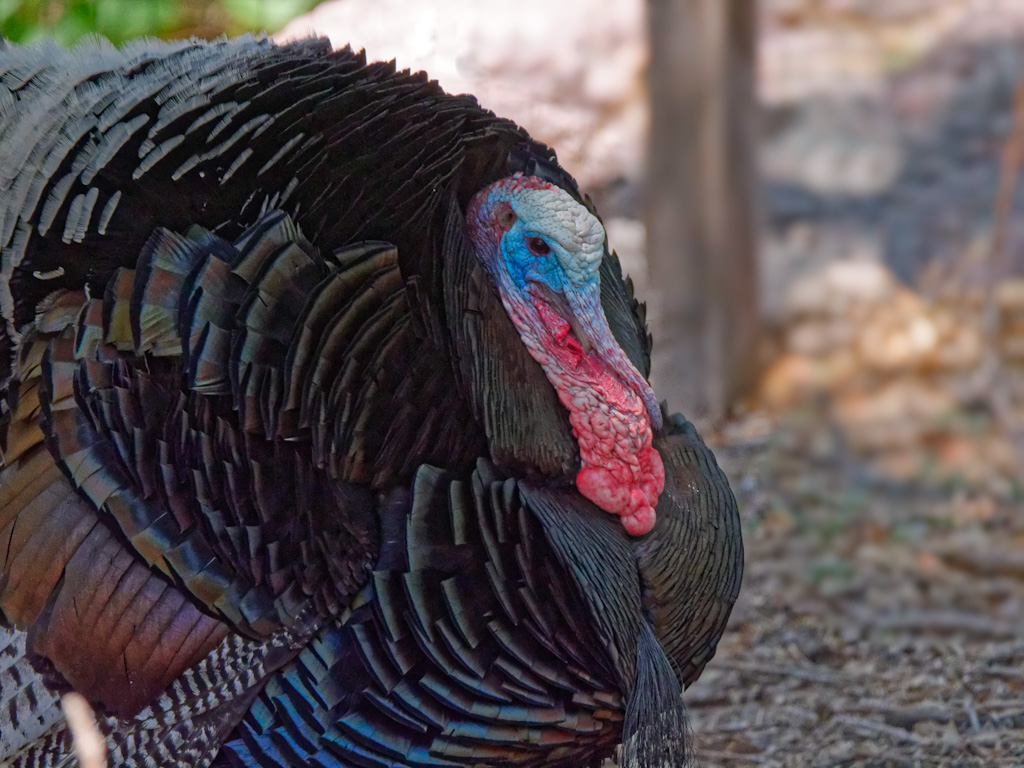
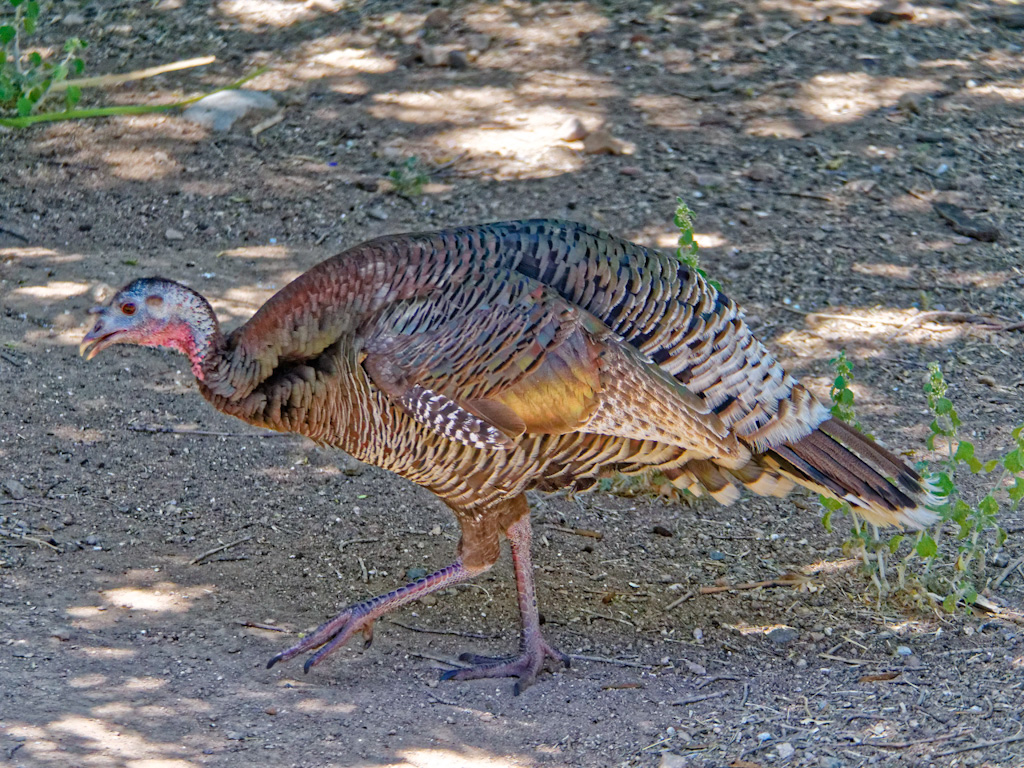
The Gould’s turkey (Meleagris gallopavo mexicana) is one of the few wild turkey subspecies that survive in the arid regions of the south-central United States and Mexico. Although there are some limited hunting opportunities in Arizona and New Mexico, you’ll likely have to head south of the border to pursue one. Here is what you need to know about our largest and rarest turkey subspecies. The Gould’s turkey subspecies is similar in weight to the Eastern wild turkey, with males weighing 18 to 30 pounds and females weighing 8 to 12 pounds on average (NWTF 2018). However, they generally are larger in size with longer legs, larger feet, and larger tail feathers than any other subspecies (Kennamer 2009). Their feathers resemble the Merriam’s turkey, but have metallic copper, greenish-gold, and bluish-green reflections instead. Differing from the Merriam’s turkey, the rump feathers and tail fan tips on Gould’s are white instead of creamy or buff-colored (Kennamer 2009). Hens have duller feathers to hide well on a nest, and the breast feathers are buff to brown with a slightly purple reflection. The Gould’s turkey is thought to have moderate length beards and spurs compared to all the turkey subspecies (NWTF 2018). The colors of male and female heads are similar to Easterns, with males having a red and blue colored head and females having bluish-gray heads with more feathers present.
Northern Goshawk
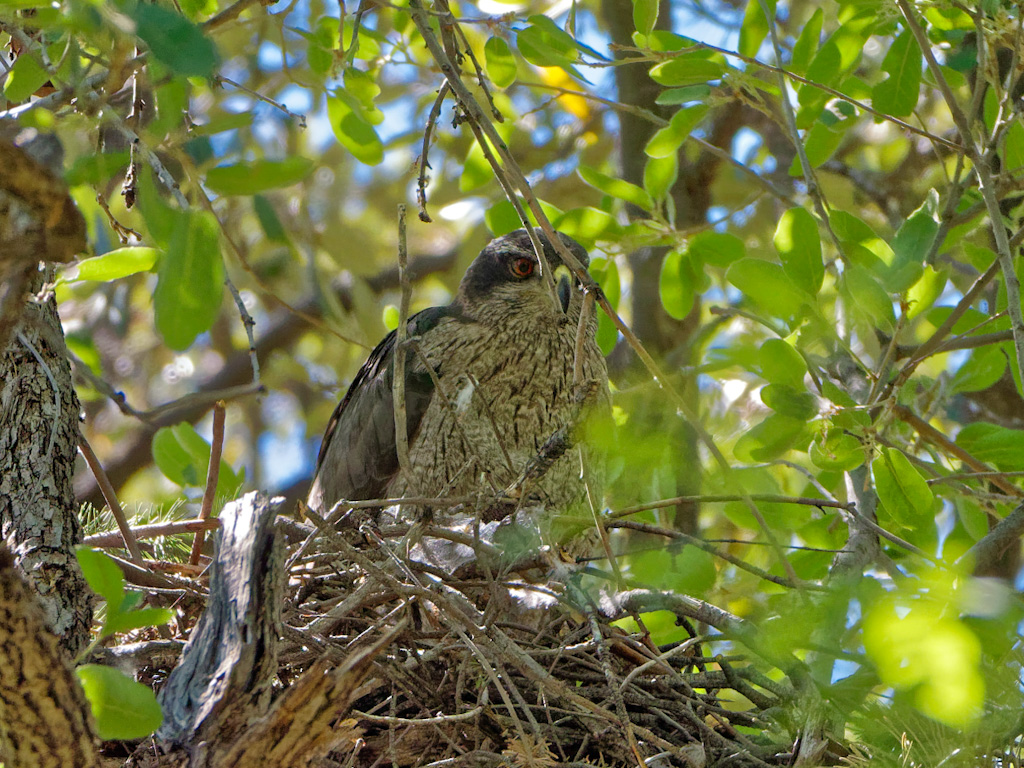
The Northern Goshawk (Accipiter gentilis) is a medium-large raptor in the family Accipitridae, which also includes other extant diurnal raptors, such as eagles, buzzards and harriers. As a species in the genus Accipiter, the goshawk is often considered a “true hawk”. The scientific name is Latin; Accipiter is “hawk”, from accipere, “to grasp”, and gentilis is “noble” or “gentle” because in the Middle Ages only the nobility were permitted to fly goshawks for falconry. The northern goshawk has a large circumpolar distribution. In Eurasia, it is found in most areas of Europe excluding Ireland and Iceland. It also has a fairly spotty distribution in western Europe (i.e. Great Britain, Spain, France) but is more or less found continuously through the rest of the continent. The northern goshawk appears to have diversified in northern, central Eurasia and spread both westwards to occupy Europe and, later on, eastwards to spread into North America across the Bering Land Bridge. Fossil remains show that goshawks were present in California by the Pleistocene era. The range of this subspecies extends from southern Arizona and New Mexico down throughout the species range in Mexico. This subspecies has the longest median wing size of any race, running contrary to Bergmann’s rule that northern birds should outsize southern ones in widely distributed temperate species.
Whiskered Screech Owl
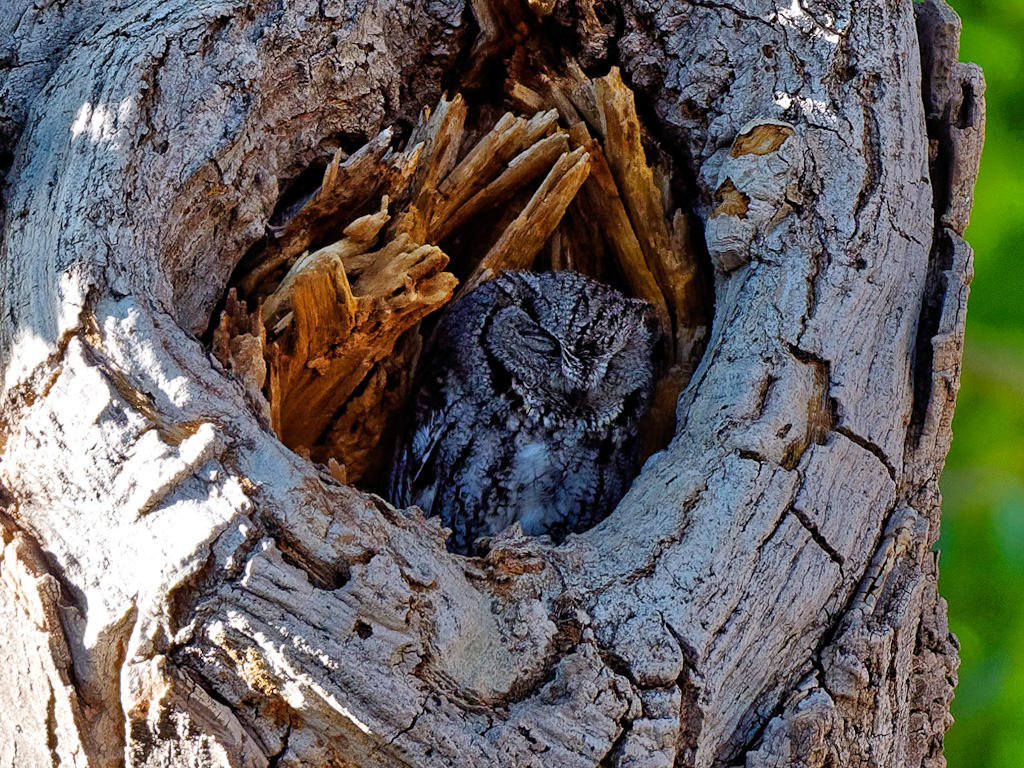
Screech owls or screech-owls are typical owls (Strigidae) belonging to the genus Megascops. Twenty-one living species are known at present, but new ones are frequently recognized and unknown ones are still being discovered on a regular basis, especially in the Andes. The whiskered screech owl’s range extends from southeasternmost Arizona (the Madrean sky islands region) in the United States, southwards through Mexico, Guatemala, El Salvador, Honduras, to north central Nicaragua. Their breeding habitat is dense coniferous or oak woodlands, and coffee plantations usually occurring at higher elevations than the western screech owl. This particular one, had a favorite perch on a tree that was cut down. Fortunately the nature reserve found another area, a valentine shaped tree hollow that was suitable to it’s liking (personally, I think they cut it out for him). You can see this owl daily (sleeping) at the San Pedro Riparian Nature Reserve in Sierra Vista.
I hope you enjoyed the the post, please leave a comment.

